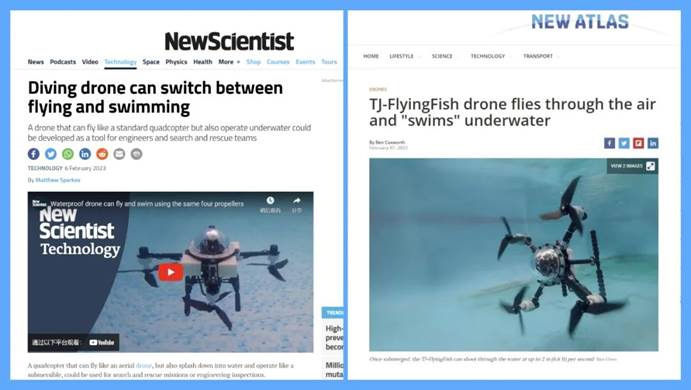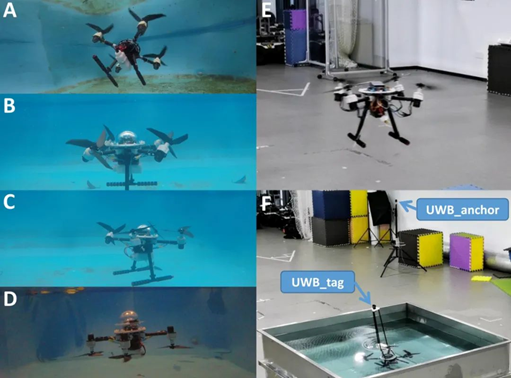On February 6, New Scientist reported an innovative prototype of an Aerial-Aquatic Quadrotor - "TJ-FlyingFish" (Tongji Flying Fish) jointly developed by Shanghai Research Institute for Intelligent Autonomous Systems (SRIFIAS) of Tongji University, National Key Laboratory and Chinese University of Hong Kong. This is an Aerial-Aquatic Quadrotor drone, which flies through the air and swims like a submersible under the water. "The diving drone can switch freely between flying and swimming", said New Scientist. It can not only serve as an irreplaceable communication channel between two unmanned systems to strengthen the integration and sharing of information, but also be independently applied to cross-domain detection, remote sensing and disaster relief. "

The Aerial-Aquatic Quadrotor prototype jointly developed by SRIFIAS, National Key Laboratory of Tongji University and Chinese University of Hong Kong team as appeared in
New Scientist and New Atlas
The research result also appeared in other international academic journals including New Atlas in North America. The research paper "TJ-FlyingFish: Design and Implementation of an Aerial-Aquatic Quadrotor with Tiltable Propulsion Units" was accepted by IEEE International Conference on Robotics and Automation, and published online on ArXiv in advance.
Cross-domain collaboration of unmanned systems has become a hot issue with the continuous development of intelligent autonomous systems. Multi-unmanned systems with different functions, which are integrated into an organic whole, can operate in sea, land and air. It will greatly enhance the correspondence of the unmanned system to cross-domain complex environment and play a very important role in improving the all-domain synaesthesia technology by means of information sharing and integration, behavior interaction and coordination, task collaboration and cooperation. However, between water and air, it is difficult to realize effective information transmission across media by using traditional communication technology, which restricts the cross-domain cooperation of unmanned systems. Therefore, development of an unmanned system platform with cross-domain navigation is an effective way to solve the cross-domain collaborative problem of unmanned systems, for the platform can act as a messenger in the cross-domain collaborative system, and realize information transmission and interaction between different media.
In this regard, a team led by Professor CHEN Jie, member of the Chinese Academy of Engineering and Professor Ben M. Chen, member of Singapore Academy of Engineering, developed the prototype of aerial-aquatic cross-domain cruiser "TJ Flying Fish". It adopts a four-rotor configuration design equipped with aerial-aquatic dual-purpose tiltable propulsion units. The prototype weighs 1.63 kg with a wheelbase of 380 mm. It can perform cross-domain transport and dual-domain navigation, hover in the air for 6 minutes and go underwater for about 40 minutes.

"TJ Flying Fish" testing
The different hydrodynamic characteristics of water and air have different requirements for the working range of the propeller and the overall working balance of the system. To solve the problem of cross-medium propulsion, the cruiser is equipped with a miniature two-speed gearbox to switch the working range of the propeller, so as to adapt to different medium environments, which greatly simplify the structure and reduce the weight, and ensure the operation efficiency in the two media at the same time. To solve the problem of system balance, based on the traditional rotor aircraft, the cruiser increases the freedom of rudder tilt, changes the thrust vector direction underwater to switch the working mode of the system. It greatly improves the cross-domain maneuverability and flexibility by meeting the different requirements of water-air media for system balance through structural changes. In addition, the cruiser is equipped with a cross-domain positioning and navigation system consisting of GPS, inertial measurement unit (IMU), depth gauge and micro Doppler velocimeter (DVL), which has automatic control in underwater, air and cross-medium processes.
Tongji University undertakes the new mission in the new era, responds to the national artificial intelligence development strategy, generates the national scientific and technological power of artificial intelligence, endows the development of traditional disciplines with new kinetic energy and enhances the new connotation of traditional advantageous disciplines with artificial intelligence. In the four years since the establishment of SRIFIAS of Tongji University, rapid progress has been made in organized research of major key projects, discipline development of intelligent science and technology peak, introduction and education of high-end talents, doctoral education, construction of major scientific and technological infrastructure, interdisciplinary integration, and industry-university-research cooperation. Outstanding achievements were made in basic theories along key research directions, core technologies and technology applications. SRIFIAS was approved to be one of the first national key laboratories, frontier science centers of the Ministry of Education, and interdisciplinary doctoral programs in intelligent science and technology, thus expanding its international influence.

Shanghai Research Institute for Intelligent Autonomous Systems
The "TJ Flying Fish" and the intelligent equipment series of underwater "Moray" and soft robot "Popeye" developed by SRIFIAS are expected to support major strategies and needs such as national marine safety and resource exploration.
Link to paper: arxiv.org/abs/2301.12344